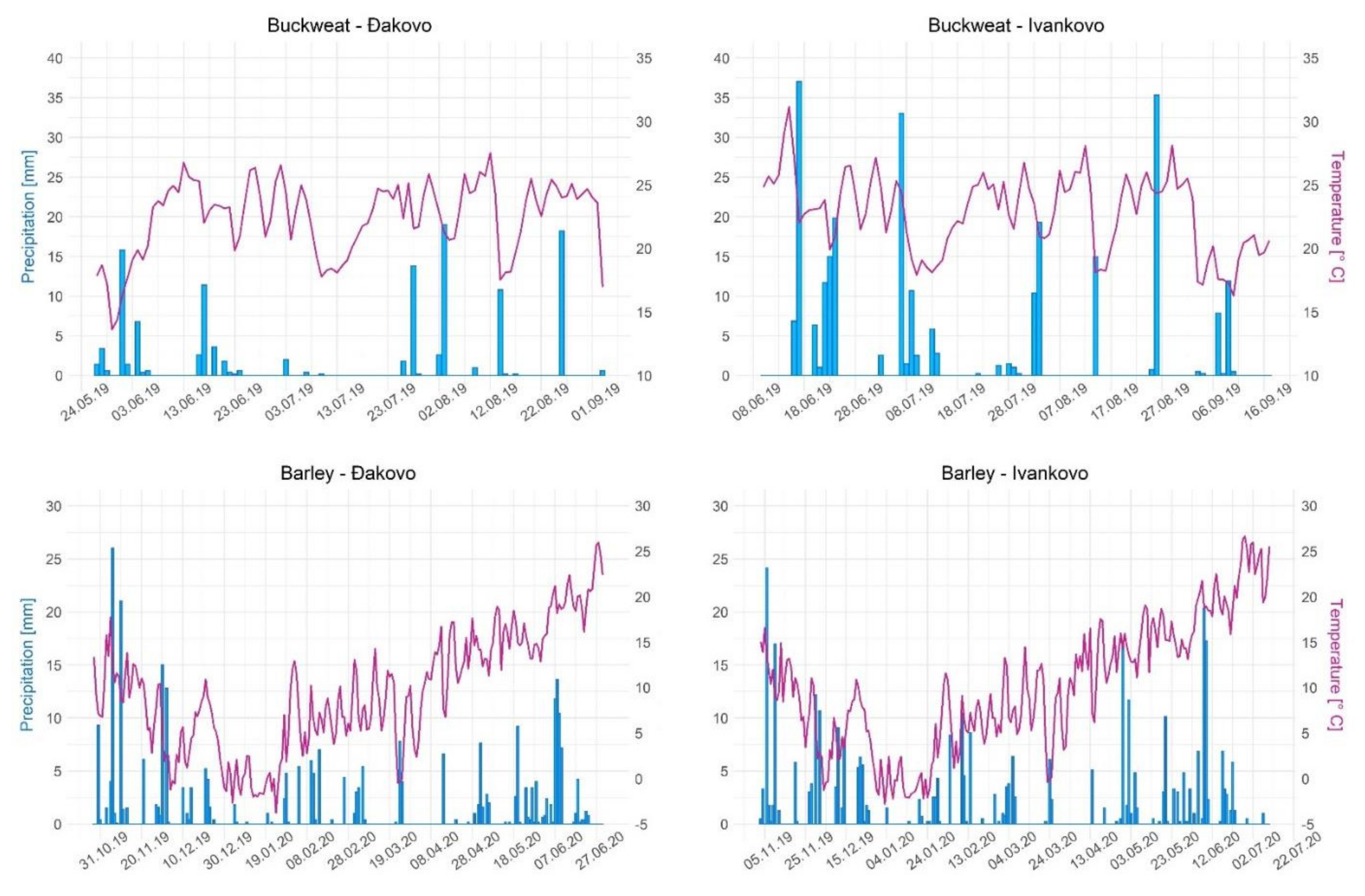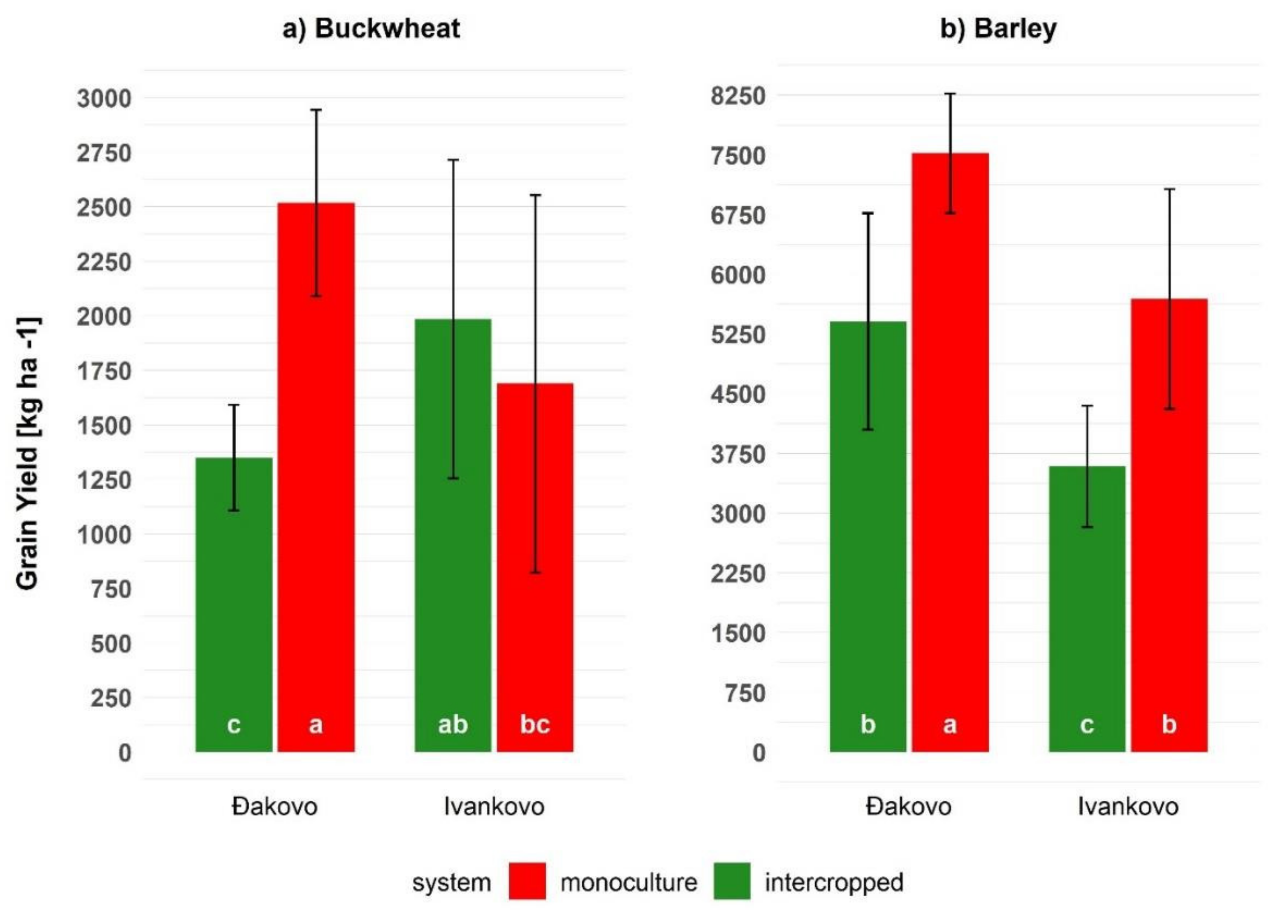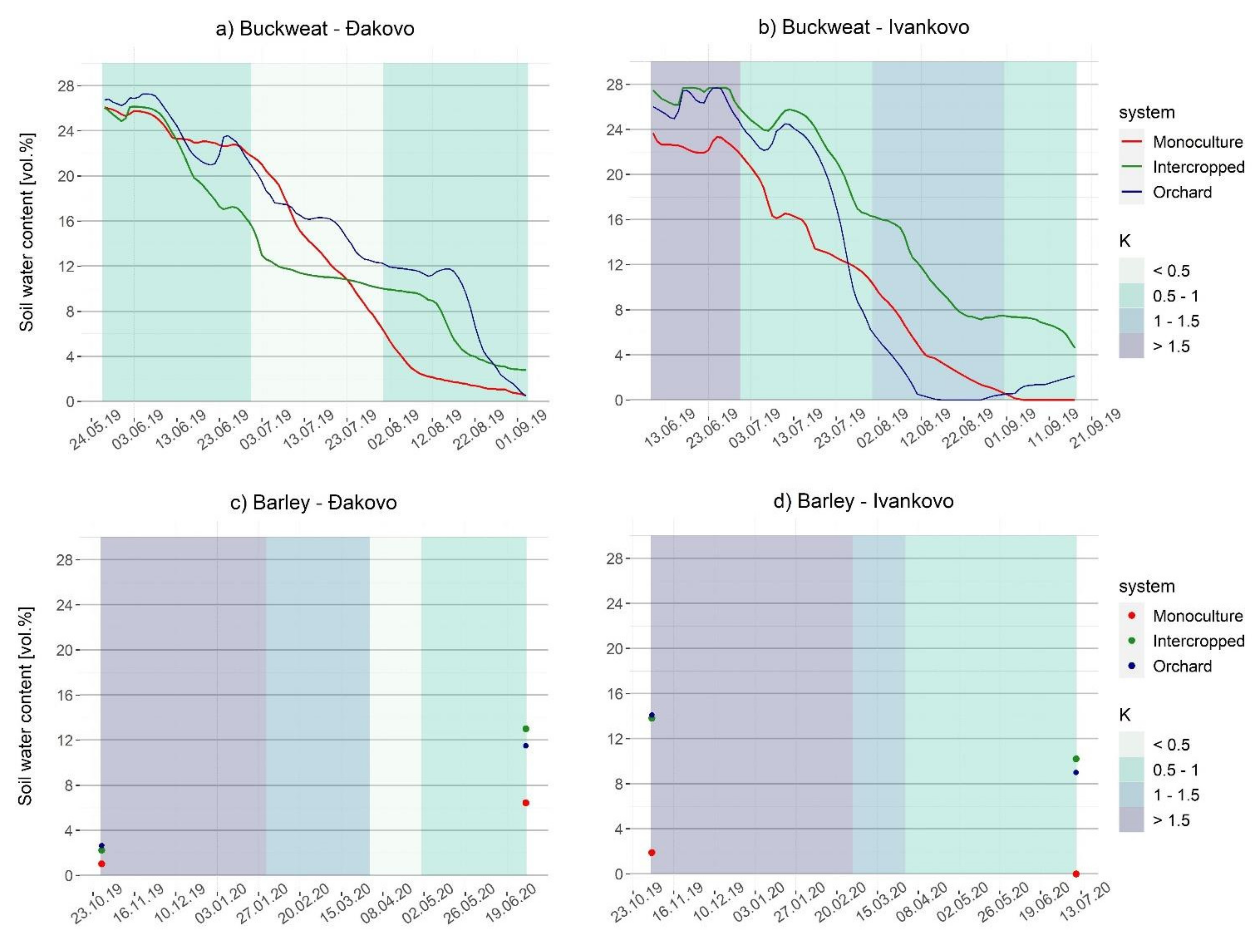Land and Water Productivity in Intercropped Systems of Walnut—Buckwheat and Walnut–Barley: A Case Study
Abstract
:1. Introduction
2. Materials and Methods
2.1. Field Experiments and Systems Description
2.2. Yields Determination
2.3. Soil Water Content
2.4. Hydrothermal Coefficient of Water Protection
- K > 1.5: excessive humidity for most plants;
- 1 < K < 1.5: humidity sufficient for most plants;
- 0.5 < K < 1.0: insufficient humidity for most plants;
- K < 0.5: drought.
2.5. Water Productivity Determination
2.6. Land and Water Equivalent Ratios
2.7. Statistical Analysis
3. Results
3.1. Yields and Land Equivalent Ratios
3.2. Soil Water Content and Air Hydrothermal Conditions
3.3. Water Productivity and Water Equivalent Ratios
4. Discussion
5. Conclusions
Author Contributions
Funding
Institutional Review Board Statement
Data Availability Statement
Acknowledgments
Conflicts of Interest
References
- Perčec Tadić, M.; Gajić-Čapka, M.; Zaninović, K.; Cindrić, K. Drought Vulnerability in Croatia. Agric. Conspec. Sci. 2014, 79, 31–38. Available online: https://hrcak.srce.hr/120753 (accessed on 10 September 2021).
- Hernández-Morcillo, M.; Burgess, P.; Mirck, J.; Pantera, A.; Plieninger, T. Scanning agroforestry-based solutions for climate change mitigation and adaptation in Europe. Environ. Sci. Policy 2018, 80, 44–52. [Google Scholar] [CrossRef] [Green Version]
- Rao, K.P.C.; Verchot, L.V.; Laarman, J. Adaptation to Climate Change through Sustainable Management and Development of Agroforestry Systems. J. SAT Agric. Res. 2007, 4, 1–30. [Google Scholar]
- Reynolds, P.E.; Simpson, J.A.; Thevathasan, N.V.; Gordon, A.M. Effects of tree competition on corn and soybean photosynthesis, growth, and yield in a temperate tree-based agroforestry intercropping system in southern Ontario, Canada. Ecol. Eng. 2007, 29, 362–371. [Google Scholar] [CrossRef]
- Burgess, P.J.; Incoll, L.D.; Corry, D.T.; Beaton, A.; Hart, B.J. Poplar (Populus spp.) growth and crop yields in a silvoarable experiment at three lowland sites in England. Agrofor. Syst. 2005, 63, 157–169. [Google Scholar] [CrossRef]
- Seserman, D.M.; Freese, D.; Swieter, A.; Langhof, M.; Veste, M. Trade-Off between Energy Wood and Grain Production in Temperate Alley-Cropping Systems: An Empirical and Simulation-Based Derivation of Land Equivalent Ratio. Agriculture 2019, 9, 147. [Google Scholar] [CrossRef] [Green Version]
- Rivest, D.; Cogliastro, A.; Bradley, R.L.; Olivier, A. Intercropping hybrid poplar with soybean increases soil microbial biomass, mineral N supply and tree growth. Agrofor. Syst. 2010, 80, 33–40. [Google Scholar] [CrossRef]
- Bai, W.; Sun, Z.; Zheng, J.; Du, G.; Feng, L.; Cai, Q.; Yang, N.; Feng, C.; Zhang, Z.; Evers, J.B.; et al. Mixing trees and crops increases land and water use efficiencies in a semi-arid area. Agric. Water Manag. 2016, 178, 281–290. [Google Scholar] [CrossRef]
- Dupraz, C.; Talbot, G.; Marrou, H.; Wery, J.; Roux, S.; Liagre, F.; Ferard, Y.; Nogier, A. To mix or not to mix: Evidences for the unexpected high productivity of new complex agrivoltaic and agroforestry systems. In Proceedings of the 5th World Congress of Conservation Agriculture Incorporating 3rd Farming Systems Design Conference, Brisbane, Australia, 26–29 September 2011; p. 203. [Google Scholar]
- Ong, C.; Black, C.; Wallace, J.; Khan, A.; Lott, J.; Jackson, N.; Howard, S.; Smith, D. Productivity, microclimate and water use in Grevillea robusta-based agroforestry systems on hillslopes in semi-arid Kenya. Agric. Ecosyst. Environ. 2000, 80, 121–141. [Google Scholar] [CrossRef]
- Jose, S.; Gillespie, A.R.; Seifert, J.R.; Biehle, D.J. Defining competition vectors in a temperate alley cropping system in the midwestern USA: 2. Competition for water. Agrofor. Syst. 2000, 48, 41–59. [Google Scholar] [CrossRef]
- Gao, L.; Xu, H.; Bi, H.; Xi, W.; Bao, B.; Wang, X.; Bi, C.; Chang, Y. Intercropping Competition between Apple Trees and Crops in Agroforestry Systems on the Loess Plateau of China. PLoS ONE 2013, 8, e70739. [Google Scholar] [CrossRef]
- Miller, A.W.; Pallardy, S.G. Resource competition across the crop-tree interface in a maize-silver maple temperate alley cropping stand in Missouri. Agrofor. Syst. 2001, 53, 247–259. [Google Scholar] [CrossRef]
- Wanvestraut, R.H.; Jose, S.; Nair, P.R.; Brecke, B.J. Competition for water in a pecan (Carya illinoensis K. Koch)—Cotton (Gossypium hirsutum L.) alley cropping system in the southern United States. Agrofor. Syst. 2004, 60, 167–179. [Google Scholar] [CrossRef]
- Bayala, J.; Prieto, I. Water acquisition, sharing and redistribution by roots: Applications to agroforestry systems. Plant Soil 2019, 453, 17–28. [Google Scholar] [CrossRef] [Green Version]
- Liu, Z.; Yu, X.; Jia, G.; Zhang, J.; Zhang, Z. Water consumption by an agroecosystem with shelter forests of corn and Populus in the North China Plain. Agric. Ecosyst. Environ. 2018, 265, 178–189. [Google Scholar] [CrossRef]
- Liu, Z.; Jia, G.; Yu, X. Water uptake and WUE of Apple tree-Corn Agroforestry in the Loess hilly region of China. Agric. Water Manag. 2020, 234, 106138. [Google Scholar] [CrossRef]
- Selyaninov, G.T. About climate agricultural estimation. Proc. Agric. Meteorol. 1928, 20, 165–177. [Google Scholar]
- Hillel, D. Introduction to Environmental Soil Physics, 1st ed.; Academic Press: Cambridge, MA, USA, 2003. [Google Scholar] [CrossRef]
- Ong, C.K.; Kho, R.M. A framework for quantifying the various effects of tree-crop interactions. In Tree-Crop Interactions: Agroforestry in a Changing Climate, 2nd ed.; CABI: Wallingford, UK, 2015; pp. 1–23. [Google Scholar] [CrossRef]
- Mead, R.; Willey, R.W. The Concept of a ‘Land Equivalent Ratio’ and Advantages in Yields from Intercropping. Exp. Agric. 1980, 16, 217–228. [Google Scholar] [CrossRef] [Green Version]
- Mao, L.; Zhang, L.; Li, W.; van der Werf, W.; Sun, J.; Spiertz, H.; Li, L. Yield advantage and water saving in maize/pea intercrop. Field Crops Res. 2012, 138, 11–20. [Google Scholar] [CrossRef]
- R Core Team. R: A Language and Environment for Statistical Computing; R Foundation for Statistical Computing: Vienna, Austria, 2021; Available online: https://www.R-project.org/ (accessed on 15 August 2021).
- Žalac, H.; Burgess, P.; Graves, A.; Giannitsopoulos, M.; Paponja, I.; Popović, B.; Ivezić, V. Modelling the yield and profitability of intercropped walnut systems in Croatia. Agrofor. Syst. 2021. [Google Scholar] [CrossRef]
- Arenas-Corraliza, M.G.; Rolo, V.; López-Díaz, M.L.; Moreno, G. Wheat and barley can increase grain yield in shade through acclimation of physiological and morphological traits in Mediterranean conditions. Sci. Rep. 2019, 9, 9547. [Google Scholar] [CrossRef]
- Sida, T.S.; Baudron, F.; Kim, H.; Giller, K.E. Climate-smart agroforestry: Faidherbia albida trees buffer wheat against climatic extremes in the Central Rift Valley of Ethiopia. Agric. For. Meteorol. 2018, 248, 339–347. [Google Scholar] [CrossRef]
- Li, H.; Jiang, D.; Wollenweber, B.; Dai, T.; Cao, W. Effects of shading on morphology, physiology and grain yield of winter wheat. Eur. J. Agron. 2010, 33, 267–275. [Google Scholar] [CrossRef]
- Rivest, D.; Vézina, A. Maize yield patterns on the leeward side of tree windbreaks are site-specific and depend on rainfall conditions in eastern Canada. Agrofor. Syst. 2014, 89, 237–246. [Google Scholar] [CrossRef]
- Slawinska, J.; Obendorf, R.L. Buckwheat seed set in planta and during in vitro inflorescence culture: Evaluation of temperature and water defcit stress. Seed Sci. Res. 2001, 11, 223–233. [Google Scholar] [CrossRef]
- Zhao, Y.; Zhang, B.; Hill, R. Water use assessment in alley cropping systems within subtropical China. Agrofor. Syst. 2011, 84, 243–259. [Google Scholar] [CrossRef]
- Germon, A.; Cardinael, R.; Prieto, I.; Mao, Z.; Kim, J.; Stokes, A.; Dupraz, C.; Laclau, J.P.; Jourdan, C. Unexpected phenology and lifespan of shallow and deep fine roots of walnut trees grown in a silvoarable Mediterranean agroforestry system. Plant Soil 2015, 401, 409–426. [Google Scholar] [CrossRef]
- Mohamed, A.; Monnier, Y.; Mao, Z.; Jourdan, C.; Sabatier, S.; Dupraz, C.; Dufour, L.; Millan, M.; Stokes, A. Asynchrony in shoot and root phenological relationships in hybrid walnut. New For. 2019, 51, 41–60. [Google Scholar] [CrossRef]
- Liu, Y.; Zhang, X.; Zhao, S.; Ma, H.; Qi, G.; Guo, S. The Depth of Water Taken up by Walnut Trees during Different Phenological Stages in an Irrigated Arid Hilly Area in the Taihang Mountains. Forests 2019, 10, 121. [Google Scholar] [CrossRef] [Green Version]
- Song, L.; Zhu, J.; Li, M.; Zhang, J. Water use patterns of Pinus sylvestris var. mongolica trees of different ages in a semiarid sandy lands of Northeast China. Environ. Exp. Bot. 2016, 129, 94–107. [Google Scholar] [CrossRef]
- Upson, M.A.; Burgess, P.J. Soil organic carbon and root distribution in a temperate arable agroforestry system. Plant Soil 2013, 373, 43–58. [Google Scholar] [CrossRef] [Green Version]
- Gondola, I.; Papp, P.P. Origin, geographical distribution and polygenic relationship of common buckwheat (Fagopyrum esculentum Moench.). Eur. J. Plant Sci. Biotechnol. 2010, 4, 17–33. [Google Scholar]
- Wallace, J.; Jackson, N.; Ong, C. Modelling soil evaporation in an agroforestry system in Kenya. Agric. For. Meteorol. 1999, 94, 189–202. [Google Scholar] [CrossRef]




| Location | Depth (cm) | Particle Size Distribution (%) | Texture Class | Bulk Density | ||
|---|---|---|---|---|---|---|
| Sand | Clay | Silt | (g cm−3) | |||
| Đakovo | 0–40 | 2.95 | 25.9 | 71.15 | silt loam | 1.51 |
| 40–60 | 2.72 | 28.07 | 69.21 | silty clay loam | 1.56 | |
| 60–125 | 2.57 | 27.72 | 69.71 | silt loam | 1.56 | |
| Ivankovo | 0–40 | 3.7 | 17.96 | 78.34 | silt loam | 1.54 |
| 40–60 | 2.73 | 29.12 | 68.15 | silt loam | 1.6 | |
| 60–110 | 2.02 | 34.02 | 63.96 | silty clay loam | 1.6 | |
| 110–140 | 2.43 | 29.95 | 67.62 | silt loam | 1.6 | |
| Year | Đakovo | Ivankovo | |||||
|---|---|---|---|---|---|---|---|
| Soil Properties | Monoculture | Intercropped Orchard | Orchard | Monoculture | Intercropped Orchard | Orchard | |
| 2019 Buckwheat | pH(H20) | 5.6 b | 6.2 b | 6.0 b | 6.0 b | 7.3 a | 5.9 b |
| AL-P2O5 mg/100 g | 10.3 bc | 7.0 bc | 5.9 c | 13.6 ab | 17.7 a | 19.1 a | |
| AL-K2O mg/100 g | 12.4 c | 13.0 c | 14.4 c | 16.5 bc | 19.1 b | 24.9 a | |
| SOM% | 1.6 a | 1.6 a | 1.6 a | 1.7 a | 1.6 a | 1.5 a | |
| 2020 Barley | pH(H20) | 5.6 c | 5.9 bc | 6.3 b | 6.2 b | 6.9 a | 5.7 c |
| AL-P2O5 mg/100 g | 9.5 bc | 6.9 c | 9.6 bc | 14.9 a | 14.5 a | 12.1 ab | |
| AL-K2O mg/100 g | 11.8 c | 14.6 bc | 18.5 a | 18.5 a | 19.5 a | 17.6 ab | |
| SOM% | 1.6 c | 2.0 ab | 2.2 a | 1.4 c | 1.6 c | 1.7 bc | |
| Location | Crop | pLERC | pLERW | LER |
|---|---|---|---|---|
| Đakovo | Buckwheat | 0.54 ± 0.09 b | 0.51 | 1.05 ± 0.09 b |
| Barley | 0.72 ± 0.18 b | 0.81 | 1.53 ± 0.18 a | |
| Ivankovo | Buckwheat | 1.17 ± 0.43 a | - | - |
| Barley | 0.63 ± 0.13 b | - | - |
| Year/Crop Species | Location | System | WP (kg ha−1 mm−1) | pWER | WER |
|---|---|---|---|---|---|
| 2019 Buckwheat | Ivankovo | Monoculture crop | 3.38 ± 1.73 b | 1.19 ± 0.44 a | - |
| Intercropped crop | 4.04 ± 1.48 b | ||||
| Đakovo | Monoculture crop | 6.68 ± 1.13 a | 0.57 ± 0.10 b | 1.12 ± 0.10 b | |
| Intercropped crop | 3.81 ± 0.68 b | ||||
| Sole walnut | 1.94 | 0.55 | |||
| Intercropped walnut | 1.07 | ||||
| 2020 Barley | Ivankovo | Monoculture crop | 15.34 ± 3.73 b | 0.60 ± 0.13 b | - |
| Intercropped crop | 9.25 ± 1.96 c | ||||
| Đakovo | Monoculture crop | 31.32 ± 3.13 a | 0.93 ± 0.23 a | 1.83 ± 0.23 a | |
| Intercropped crop | 28.99 ± 7.30 a | ||||
| Sole walnut | 12.76 | 0.90 | |||
| Intercropped walnut | 11.45 |
Publisher’s Note: MDPI stays neutral with regard to jurisdictional claims in published maps and institutional affiliations. |
© 2022 by the authors. Licensee MDPI, Basel, Switzerland. This article is an open access article distributed under the terms and conditions of the Creative Commons Attribution (CC BY) license (https://creativecommons.org/licenses/by/4.0/).
Share and Cite
Žalac, H.; Zebec, V.; Ivezić, V.; Herman, G. Land and Water Productivity in Intercropped Systems of Walnut—Buckwheat and Walnut–Barley: A Case Study. Sustainability 2022, 14, 6096. https://doi.org/10.3390/su14106096
Žalac H, Zebec V, Ivezić V, Herman G. Land and Water Productivity in Intercropped Systems of Walnut—Buckwheat and Walnut–Barley: A Case Study. Sustainability. 2022; 14(10):6096. https://doi.org/10.3390/su14106096
Chicago/Turabian StyleŽalac, Helena, Vladimir Zebec, Vladimir Ivezić, and Goran Herman. 2022. "Land and Water Productivity in Intercropped Systems of Walnut—Buckwheat and Walnut–Barley: A Case Study" Sustainability 14, no. 10: 6096. https://doi.org/10.3390/su14106096
APA StyleŽalac, H., Zebec, V., Ivezić, V., & Herman, G. (2022). Land and Water Productivity in Intercropped Systems of Walnut—Buckwheat and Walnut–Barley: A Case Study. Sustainability, 14(10), 6096. https://doi.org/10.3390/su14106096






